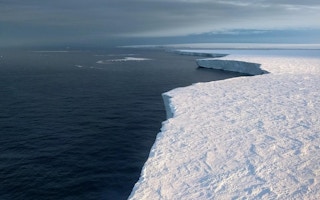A team of British and American scientists has found what it says is unequivocal evidence that humans are responsible for significant Antarctic ice melt.
They say their study provides the first evidence of a direct link between global warming from human activities and the melting of the West Antarctic Ice Sheet (WAIS).
The discovery is fundamentally important to international efforts to limit climate change, as a small number of scientists still argue that global warming results from natural rather than human causes. That argument should from now on be harder to sustain.
Ice loss in West Antarctica has increased substantially in the last few decades, and is continuing. Scientists have known for some time that the loss is caused by melting driven from the ocean, and that varying winds in the region cause transitions between relatively warm and cool ocean conditions around key glaciers. But until now it was unclear how these naturally-occurring wind variations could cause the ice loss.
The UK-US team report in the journal Nature Geoscience that, as well as the natural wind variations, which last about a decade, there has been a much longer-term change in the winds that can be linked with human activities.
This result is important for another reason as well: continued ice loss from the WAIS could cause tens of centimetres of sea level rise by the year 2100.
“
We knew this region was affected by natural climate cycles lasting about a decade, but these didn’t necessarily explain the ice loss. Now we have evidence that a century-long change underlies these cycles, and that it is caused by human activities.”
Pierre Dutrieux, scientist, Lamont-Doherty Earth Observatory
The researchers combined satellite observations and climate model simulations to understand how winds over the ocean near West Antarctica have changed since the 1920s in response to rising greenhouse gas concentrations.
Their investigation shows that human-induced climate change has caused the longer-term change in the winds, and that warm ocean conditions have gradually become more prevalent as a result.
The team’s members are from the British Antarctic Survey (BAS), Columbia University’s Lamont-Doherty Earth Observatory in New York, and the University of Washington.
Galloping speed-up
BAS is one of the organisations researching a huge West Antarctic ice mass in the International Thwaites Glacier Collaboration, aimed at finding out how soon it and its neighbour, the Pine Island glacier, may collapse, with implications for sea levels worldwide.
The fact that melting at both poles has been accelerating fast has been known for some time, though not the reason. Since 1979 Antarctica’s ice loss has grown six times faster, and Greenland’s four times since the turn of the century.
One British scientist, Professor Martin Siegert, has said what is happening in the Antarctic means the world “will be locked into substantial global changes” unless it alters course radically by 2030.
The lead author of the new study, Paul Holland from BAS, said the impact of human-induced climate change on the WAIS was not simple: “Our results imply that a combination of human activity and natural climate variations have caused ice loss in this region, accounting for around 4.5 cm of sea level rise per century.”
Act now
The team also looked at model simulations of future winds. Professor Holland added: “An important finding is that if high greenhouse gas emissions continue in future, the winds keep changing and there could be a further increase in ice melting.
“However, if emissions of greenhouse gases are curtailed, there is little change in the winds from present-day conditions. This shows that curbing greenhouse gas emissions now could reduce the future sea level contribution from this region.”
One co-author, Professor Pierre Dutrieux from Lamont-Doherty Earth Observatory, said: “We knew this region was affected by natural climate cycles lasting about a decade, but these didn’t necessarily explain the ice loss. Now we have evidence that a century-long change underlies these cycles, and that it is caused by human activities.”
Another co-author, Professor Eric Steig from the University of Washington, said: “These results solve a long-standing puzzle. We have known for some time that varying winds near the West Antarctic Ice Sheet have contributed to the ice loss, but it has not been clear why the ice sheet is changing now.
“Our work with ice cores drilled in the Antarctic Ice Sheet have shown, for example, that wind conditions have been similar in the past. But the ice core data also suggest a subtle long-term trend in the winds. This new work corroborates that evidence and, furthermore, explains why that trend has occurred.”
This story was published with permission from Climate News Network.

















